
The Nkwe ya Selefera - Silver Leopard, post-nominal letters NS, was instituted by the President of the Republic of South Africa on 16 April 2003 and came into effect on 27 April 2003. It is South Africa's second highest military decoration for bravery.

The Honoris Crux of 1952, post-nominal letters HC, is a military decoration for bravery which was instituted by the Union of South Africa in 1952. It was in use from 1952 to 1975 and was awarded to members of the South African Defence Force for gallantry in action against the enemy in the field. It was discontinued on 1 July 1975, when it was replaced by a new set of four Honoris Crux decorations, in four classes.
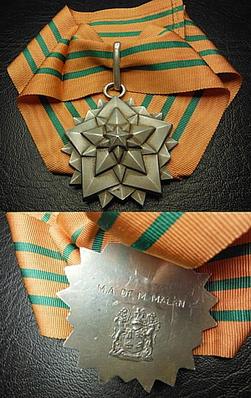
The Star of South Africa, post-nominal letters SSA, is a military decoration for merit which was instituted by the Union of South Africa from 1952 to 1975. It was awarded to general and flag officers of the South African Defence Force for exceptionally meritorious service. The Star of South Africa was discontinued on 1 July 1975, when a new set of orders, decorations and medals was instituted.
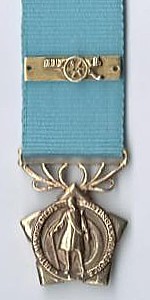
The Van Riebeeck Decoration, post-nominal letters DVR, is a South African military decoration for bravery which was instituted by the Union of South Africa in 1952. It was awarded to officers for distinguished service in the field.

The Van Riebeeck Medal, post-nominal letters VRM, is a military decoration for bravery which was instituted by the Union of South Africa in 1952. It was awarded to other ranks for distinguished service in the field.

The Louw Wepener Medal, post-nominal letters LWM, is a South African military decoration for bravery which was instituted by the Republic of South Africa on 20 October 1967. It was awarded to members of the South African Defence Force for courageous or heroic deeds in saving lives. The Louw Wepener Medal was discontinued on 1 July 1975, when a new set of decorations and medals was instituted.

The Pro Merito Medal of 1967, post-nominal letters PMM, is a military decoration which was instituted by the Republic of South Africa in 1967. It was awarded to other ranks of the South African Defence Force for outstanding devotion to duty and was the non-commissioned officers' version of the Southern Cross Medal of 1952 (SM), which had earlier been available to all ranks.

The Permanent Force Good Service Medal was instituted by the Republic of South Africa in 1961, when South Africa became a republic, to replace the Union Medal. It was awarded to Permanent Force members of the South African Defence Force for eighteen years of service and good conduct.

The John Chard Decoration, post-nominal letters JCD, was a military long service decoration which was instituted by the Union of South Africa on 6 April 1952. It was awarded to members of the Citizen Force of the South African Defence Force for twenty years of efficient service and good conduct. Clasps could be awarded after thirty and forty years service respectively.

The Honoris Crux Gold, post-nominal letters HCG, is a South African military decoration for bravery which was instituted in 1975. It was awarded to members of the South African Defence Force for outstanding acts of bravery while in extreme danger. It was the second most senior in a set of four classes of Honoris Crux decorations which replaced the discontinued Honoris Crux of 1952.

The Pro Virtute Decoration, post-nominal letters PVD, is a military decoration for bravery which was instituted by the Republic of South Africa in 1987. It was awarded to officers of the South African Defence Force for distinguished conduct and exceptional leadership during combat operations in the field.
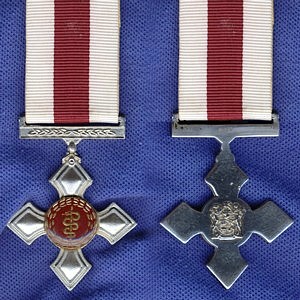
The Medical Service Cross, post-nominal letters CC, is a military decoration which was instituted by the Republic of South Africa in 1987. It was awarded to members of the South African Medical Service for bravery. The Medical Service Cross was discontinued in 2003, but backdated awards can still be made for acts of bravery during this period.

The Pro Merito Medal of 1975, post-nominal letters PMM, is a military decoration which was instituted by the Republic of South Africa on 1 July 1975. It was awarded to other ranks of the South African Defence Force for exceptionally meritorious service and particular devotion to duty, and was the non-commissioned officers' version of the Southern Cross Medal of 1975 (SM).

The Medal for Distinguished Conduct and Loyal Service is a South African military medal which was instituted by the Republic in 1987. It was awarded to members of the South African Defence Force for forty years of loyal service and distinguished conduct.

The Union Medal was instituted by the Union of South Africa in 1952. It was awarded to Permanent Force members of the South African Defence Force for eighteen years of service and good conduct.
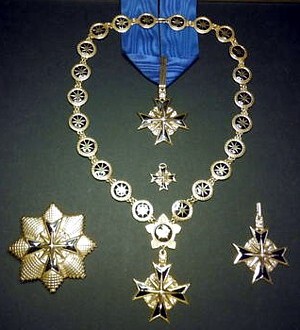
The Star of South Africa, Gold, post-nominal letters SSA, is the senior decoration of two military and five non-military classes of the Order of the Star of South Africa, a South African Order which was instituted in 1975, and awarded to general and flag officers of the South African Defence Force. The Order of the Star of South Africa was discontinued in 2002.

The Distinguished Gallantry Medal was instituted by the State President of the Republic of Bophuthatswana in 1982, for award to all ranks for extraordinary gallantry.
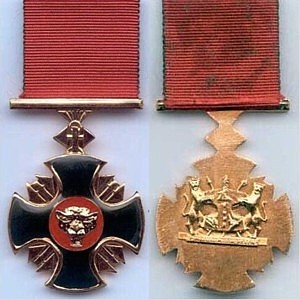
The Distinguished Gallantry Cross was instituted by the State President of the Republic of Bophuthatswana in 1982, for award to all ranks for hair-raising deeds of distinguished heroism.
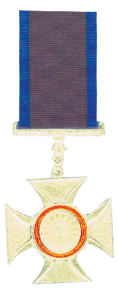
The Gallantry Cross, Gold was instituted by the President of the Republic of Venda in 1985, for award to all ranks for extreme courage or supreme bravery or valour beyond the normal call of duty.

The Gallantry Cross, Silver, post-nominal letters GCS, was instituted by the President of the Republic of Venda in 1985, for award to all ranks for courage or bravery or valour beyond the normal call of duty.





















